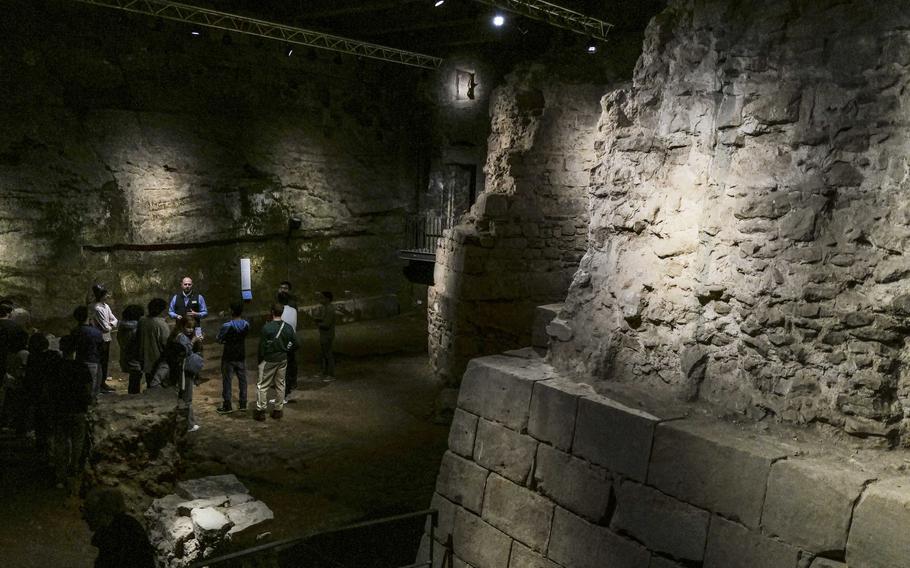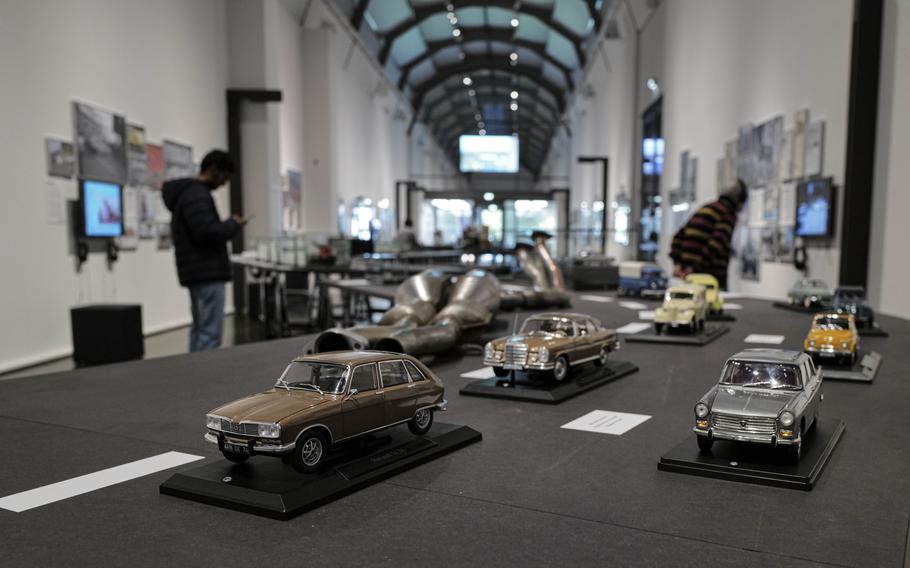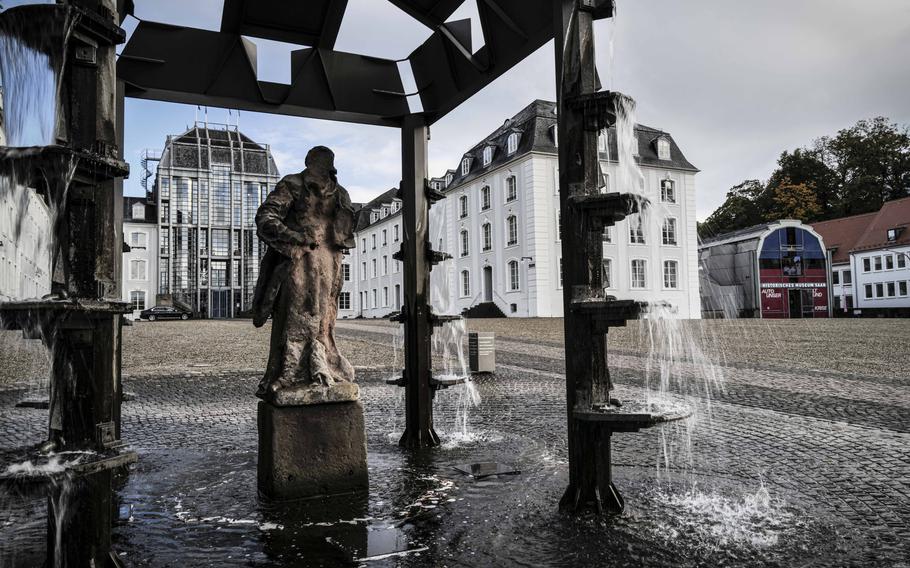
A guide leads a student tour group to the site of the old ball court and adjacent dungeon at the Saar Historical Museum in Saarbruecken, Germany, on Oct. 19, 2023. The ball court allowed castle residents to play early forms of tennis and racquetball. (Alexander Riedel/Stars and Stripes)
During fall and winter, Europe’s museums and art galleries are often a great way to get out of the cold and rain while exploring a new town.
On a crisp afternoon recently, my wife and I took one of these welcome detours in Saarbruecken. We were immediately struck by the imposing facade of the Saarbruecken Castle, which is home to the Saar Historical Museum.
The museum entrance is tucked away in a side access point that could be easily overlooked. After passing through the small bookshop, we entered an exhibition space with a temporary display tracing the post-World War II love affair between Germans and their automobiles.
The exhibit was thoughtfully curated, offering English translations via QR codes for visitors who don’t speak German.
While my wife and I are not particularly passionate about cars, we found ourselves engrossed in the photographs and old ads highlighting the Saar region’s automotive industry.

Visitors explore a temporary exhibit on automobile culture in Saarland at the Saar Historical Museum in Saarbruecken, Germany, on Oct. 19, 2023. The exhibit offers insights into the Saar region's deep connection to the car industry, showcasing its historical significance and impact. (Alexander Riedel/Stars and Stripes)
We were surprised to find that the building itself occupies only a small part of the museum. The real treasures lie beneath, with more than 90% of the exhibition rooms located underground.
Descending a staircase, we entered a subterranean space showing fortifications and artifacts that span more than 500 years of this French-German history.
Evidence points to fortifications overlooking the Saar River at this location since the 10th century, a time when the region was marked by shifting fiefdoms and territorial disputes.
Starting in the 16th century, the medieval castle underwent a Renaissance makeover, resulting in a more opulent and refined palace structure above. What remained from the medieval castle was the imposing stone keep integrated into later designs.
Descending over a metal gangway, we explored the defensive structures and gun emplacements. Props allowed us to imagine the gunners’ thankless tasks when the castle walls were still in the open air.
A particular curiosity was the ball court in the former moat. Barely recognizable now, the small area once served as a training ground for an early version of tennis, and a wall offered space for a game similar to racquetball.
A witness to both French and German history, the palace burned in the aftermath of the French Revolution. Disputes regarding its reconstruction led to its auction by none other than Napoleon Bonaparte in 1809.
Changes continued throughout much of the 20th century. The most notable addition was the construction of the contemporary glass-and-steel centerpiece by the German architect Gottfried Boehm in the 1980s.

Visitors closely inspect a medieval Italian bassinet helmet found in 1976 during archaeological digs at the Saarbruecken Castle in Saarbruecken, Germany, on Oct. 19, 2023. The helmet's scars tell a tale of past combat, offering a tangible connection to the castle's turbulent history. (Alexander Riedel/Stars and Stripes)
After exploring the dusty underground tunnels, we visited the museum’s permanent exhibit, which takes visitors on a journey through the region’s local history, from the Franco-Prussian War in 1870 to the 1960s.
Meticulously curated displays feature artifacts, documents and interactive installations offering a glimpse of the lives of the people in the Saar region.
Displays depicted the impact of both world wars on the region. Letters, uniforms and personal items shed a local light on the hardships and serve as a solemn reminder of the region’s resilience.
The most impactful exhibit, however, was a large basement room examining Nazi rule in Saarland. The Gestapo claimed the palace as its local headquarters.
Visitors can explore an original jail cell and see inscriptions that detainees wrote on the walls. The messages in French, Polish and other languages left us in a somber mood.
Unbeknownst to us until afterward, on our arrival we had walked over a memorial to what happened in this underground chamber.
In the early 1990s, German college students and their professor went on a mission to memorialize the Jewish cemeteries that once existed in Germany.
They secretly inscribed the names of 2,146 cemeteries on cobblestones before replacing them face down, thus creating what is today recognized as the “Invisible Memorial.”

The grand entrance to the Saarbruecken Palace and pavestones marking the Invisible Memorial, in Saarbruecken, Germany, on Oct. 19, 2023. In the 1990s, college students removed pavestones and engraved them with the locations of Jewish cemeteries in Germany before placing them back, face-down, in front of the palace as a silent remembrance of the victims of the Nazi regime. (Alexander Riedel/Stars and Stripes)
As we stepped back into the cool evening air over these stones, not knowing which ones held the engraved reminders, we paused at the palace’s garden terrace to appreciate how much change this place has seen over time.
After hours of exploration, we decided that this was one of the most informative local historical museums we’ve visited. It is well worth a stop, rain or shine.
On the QT
Address: Schlossplatz 15, Saarbruecken, Germany
Hours: Tuesday through Sunday, 10 a.m.-6 p.m.; closed Mondays, Christmas and New Year’s Day.
Cost: Tickets are 7 euros per adult, free for people under 18. Admission is free for everyone on the first Wednesday of each month.
Information: 0681 5064506, Online: historisches-museum.org/startseite-en